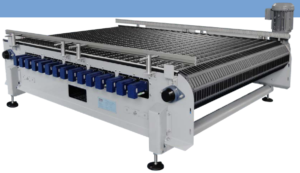Tolomatic ERD electric actuators help global conveyor manufacturer Intralox make all the right moves
Problem:
Reduce maintenance costs and improve speed and precision of pallet layer formerly used in a variety of industries including washdown environments.
Solution:
ERD electric rod actuators in all-304 stainless steel with IP67 ingress protection replace in-house actuator solution.
Results:
Reduced maintenance costs, increased speed, precision and equipment performance with programming flexibility.
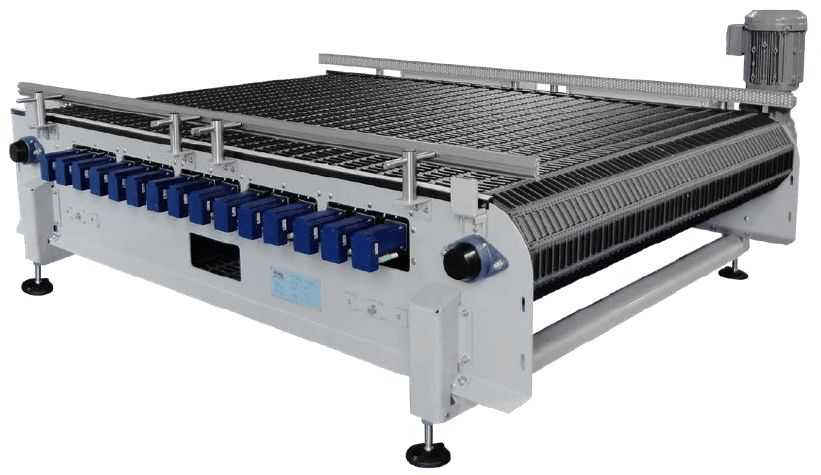
Tolomatic ERD electric actuators help global conveyor manufacturer Intralox make all the right moves
For companies involved in food and beverage manufacturing or warehousing, fast and efficient conveying and palletizing systems are critical to success. Conveying systems not only move product from point A to point B, but include actuators that sort, divert, turn and help to automatically arrange containers into pallet layers. This increased automation is helping to reduce labor and lower costs while preventing damage to containers or their contents. Intralox, Harahan, La., a leading global supplier of conveying systems, was looking to improve the speed and precision of its ARB™ Pallet Layer Former S7000 machine. Pneumatic cylinders did not provide enough flexibility, and early electric solutions were not suitable for washdown applications. A collaborative product development effort led to the design of a fully enclosed electric actuator that reduced maintenance and improved the palletizing unit’s performance and precision. This prototype was the basis for the ERD actuator from Tolomatic, Inc., designed as a cost-effective replacement for pneumatic cylinders, especially in washdown applications.
Intralox’s palletizing unit features the company’s Activated Roller Belt™ (ARB™) technology that not only moves containers linearly but has the ability to move them either left or right, turn them around or sort them to a specific location in a pallet layer. The conveyor belt is able to do this thanks to actuators located in zones beneath the moving belt that activate longitudinal rollers in the ARB™, making them rotate left or right. As a package passes over a diversion zone, for example, the actuators beneath the belt rotate pinions that cause the longitudinal rollers in the belt to rotate as they pass over, moving the container laterally by a predefined amount. Any given 10-foot section of the ARB™ may contain 8 to 16 actuators, depending on the complexity of the application. With this arrangement, packages can be pushed a few degrees right or left, make a complete 90-degree turn or anything in between as they move along the belt.

In the past, Intralox used pneumatic cylinders to activate the pinions beneath the belt, but they could only provide fixed increments, meaning there was less flexibility in what the ARB™ could do. Going to an in-house-designed electric actuator solution allowed more precise movements of the actuators and provided more flexibility in diverting, sorting and turning of containers. However, the in-house actuator proved to be less than a total solution.
Problems arise
“We originally were making our own custom-designed ball screw with another vendor,” said David Marsh, senior electrical controls engineer with Intralox. “It was essentially just an open ball screw driven by a stepper motor. Because the ball screw was unprotected, it required more maintenance and was not well suited to washdown applications in food and beverage — one of our largest markets. Tolomatic came in and said they could build us a better solution, so they took what we had and made it better.”
In conjunction with Tolomatic’s area distributor, Penn Air and Hydraulics in York, Pa., Tolomatic began designing a number of prototype actuators that would be simple, affordable, and work in food and beverage washdown applications.
“We were already providing Intralox with pneumatic cylinders,” said Jon Blum, sales engineer with Penn Air and Hydraulics, “but they were finding that a lot of their customers today do not want to use air cylinders. They want the controllability of a motor-driven electric actuator. So, with Tolomatic’s help, we sought to transition them to a better electrical solution than they had developed in-house.”
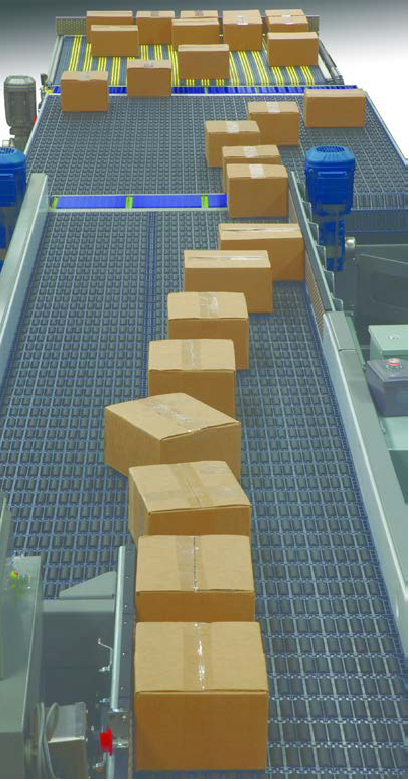
Tolomatic ERD electric actuators are used to organize pallet layers in the Intralox ARB™
alignment conveyor system.
Development leads to new product line
In the process of developing an actuator solution for Intralox, Tolomatic used information gathered from Intralox and other similar customers to design completely new catalog product line called the ERD. From the beginning, the electric rod style ERD actuator was designed to be an economical replacement for a pneumatic cylinder that would stand up to hard use in food and beverage washdown applications.
Tolomatic initially visited Intralox as part of Tolomatic’s “Voice of the Customer” research effort. “Intralox’s input on what they needed as a solution was used in our product development process. By listening to customers’ needs, we are better able to develop solutions for specific markets. Intralox is an ideal customer for product development guidance, and Dave Marsh’s feedback to us was directly incorporated into the development of the ERD.”
Some of the specifications that Tolomatic built into the prototypes for Intralox have been retained in the standard catalog product line. These features include force capabilities up to 500 pounds, all-304 stainless steel body construction, configurable stroke lengths up to 24 inches and ingress protection to IP67. Since then, the product family has expanded with forces now reaching 4500 pounds and longer stroke capacities.
“It was an extensive process to get to where we are today with a standardized global actuator product for use in their conveyor product line,” said Blum. “The final design for Intralox was completed in late 2012 and is now used in applications around the world.”
Unique application
Intralox drives the ERD with a high-torque stepper motor through a coupling designed by Tolomatic to stand up to harsh use. The actuator only moves +/- 6 mm each time it activates a pinion beneath the moving belt, causing a longitudinal roller in the belt to rotate right or left. The duration of the actuator stroke is only 50 milliseconds, but with a conveyor belt moving 250 packages per minute, the actuator moves four times a second. “This represents only a 25 percent duty cycle,” said Marsh, “but it’s still a lot of movement, force and action on a ball screw. In addition to durability, Tolomatic ERD gives us flexibility and programmability, and in most of our applications, it’s the best choice.”
Many of Intralox’s applications involve sortation work for food manufacturers and food and beverage warehouses. “What they want to do is put five boxes down one lane and five down another lane. What’s unique with this ARB™ technology is that once we shift it to the divert position, we can stay in that position, and everything behind the first one is going to go left or right,” said Marsh. “This is unlike a popup-style diverter where you have to return it to the zero position before you can divert another box. We can actually do a ‘slug’ of products, which can optimize a lot of throughput for our customers.”
Global parts availability
Another concern Intralox had with its in-house ball screw design was that replacement parts were hard to source for customers overseas. Since Tolomatic’s markets are global like Intralox’s, there is an existing supply network to help customers with repair, service or parts anywhere in the world. Marsh summed it up by saying: “The solution has gone from our small, custom-designed actuator to this globally supported ERD product.” For Intralox, it means that the company’s global product support is now running as smoothly as its state-of-the-art conveyor systems.
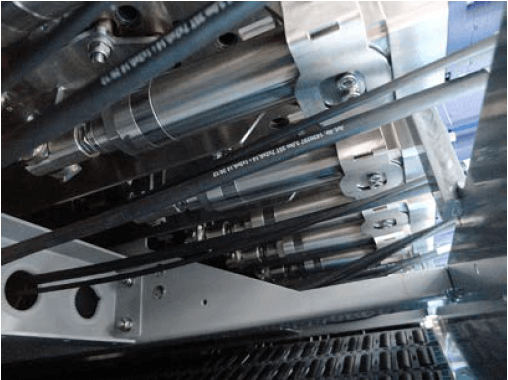
The low-maintenance features of the Tolomatic ERD actuators are important in
this application due to the tight mounting quarters.
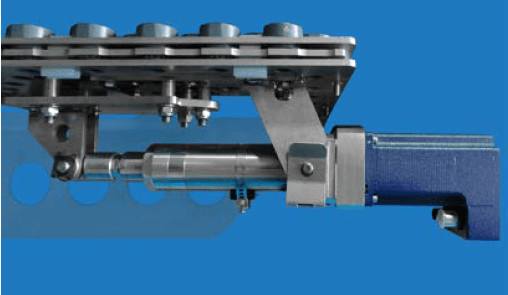
As the Tolomatic ERD actuator moves in and out, it activates the center plate above
that rotates the cams on the top plate. These cams, in turn, activate rollers in the moving
belt to create lateral movement.

 Ask an Engineer
Ask an Engineer